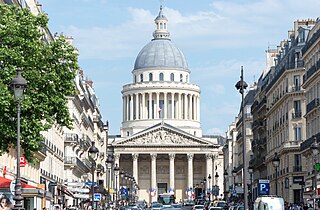
The 5th arrondissement of Paris is one of the 20 arrondissements of the capital city of France. In spoken French, this arrondissement is referred to as le cinquième.
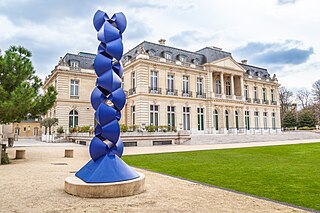
The 16th arrondissement of Paris is the westernmost of the 20 arrondissements of Paris, the capital city of France. Located on the Right Bank, it is adjacent to the 17th and 8th arrondissements to the northeast, as well as to Boulogne-Billancourt, Hauts-de-Seine to the southwest. Opposite the Seine are the 7th and 15th arrondissements.

The 2nd arrondissement of Paris is one of the 20 arrondissements of the capital city of France. In spoken French, this arrondissement is colloquially referred to as deuxième. It is governed locally together with the 1st, 3rd and 4th arrondissement, with which it forms the 1st sector of Paris.

Rue de la Pompe is a station on line 9 of the Paris Métro, named after the Rue de la Pompe. The station opened on 8 November 1922 with the opening of the first section of the line from Trocadéro to Exelmans.

Passy is an area of Paris, France, located in the 16th arrondissement, on the Right Bank. It is adjacent to Auteuil to the southwest, and Chaillot to the northeast.

Wallace fountains are public drinking fountains named after, financed by and roughly designed by Sir Richard Wallace. The final design and sculpture is by Wallace's friend Charles-Auguste Lebourg. They are large cast-iron sculptures scattered throughout the city of Paris, France, mainly along the most-frequented sidewalks. A great aesthetic success, they are recognized worldwide as one of the symbols of Paris. A Wallace fountain can be seen outside the Wallace Collection in London, the gallery that houses the works of art collected by Sir Richard Wallace and the first four Marquesses of Hertford.

The Rue de la Paix is a fashionable shopping street in the centre of Paris. Located in the 2nd arrondissement, running north from the Place Vendôme and ending at the Opéra Garnier, it is best known for its jewellers, such as the shop opened by Cartier in 1898. Charles Frederick Worth was the first to open a couture house in the Rue de la Paix. Many buildings on the street are inspired in design by the hôtels particuliers of Place Vendôme.
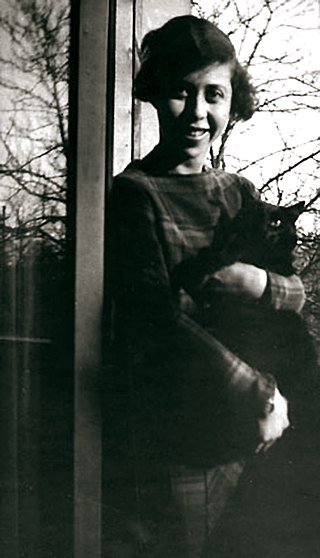
Irène Némirovsky was a novelist of Ukrainian Jewish origin who was born in Kiev, then in the Russian Empire. She lived more than half her life in France and wrote in French, but was denied French nationality. Arrested as a Jew under the racial laws – which did not take into account her conversion to Roman Catholicism – she was murdered in Auschwitz at the age of 39. Némirovsky is best known for the posthumously published Suite française.
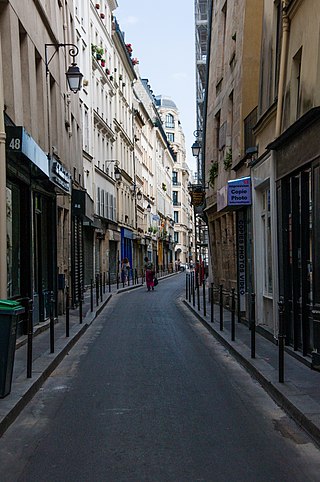
The Rue de Montmorency is a street in the historic Le Marais quarter of Paris, part of the city's 3rd arrondissement. It runs from the Rue du Temple to the Rue Saint-Martin.

The Rue du Chat-qui-Pêche is considered the narrowest street in Paris. It is only 1.80 m wide for the whole of its 29 m length.
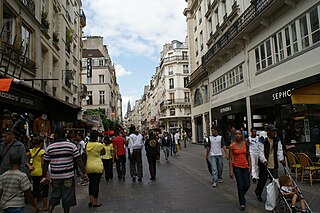
The Rue Saint-Denis is one of the oldest streets in Paris. Its route was first laid out in the 1st century by the Romans, and then extended to the north in the Middle Ages. From the Middle Ages to the present day, the street has been notorious as a place of prostitution. Its name derives from it being the historic route to Saint-Denis.

Henri Paul Nénot was a noted French architect.

The Rue du Faubourg-Saint-Denis is a street in the 10th arrondissement of Paris. It crosses the arrondissement from north to south, linking the Porte Saint-Denis to La Chapelle Métro station and passing the Gare du Nord.

The Avenue Henri-Martin is an avenue in the 16th arrondissement of Paris, named after the French historian Henri Martin (1810–1883), onetime mayor of the 16th arrondissement.
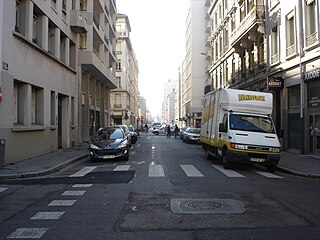
La Rue de Créqui is a very long street located in the 7th, 3rd and 6th arrondissements of Lyon. It is a long straight line along the rue Duguesclin or the rue de Vendôme, that begins on the Grande Rue de la Guillotière in the 7th arrondissement and ends at the north in the 6th, on the Boulevard des Belges. It follows the Place Guichard, located in the 3rd arrondissement.
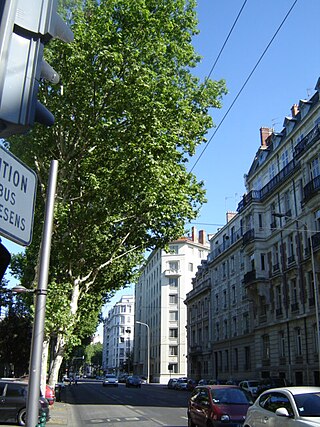
The Boulevard des Belges is a wide and posh avenue located in Les Brotteaux quarter, in the 6th arrondissement of Lyon. It begins with the Quai de Grande Bretagne, runs along the southern part of the Parc de la Tête d'Or until the Avenue Verguin and ends on the Place Jules Ferry, in front of the Gare des Brotteaux. The boulevard is lined with plane trees and is served by two velo'v stations and the line B of the metro.

The Rue Bonaparte is a street in the 6th arrondissement of Paris. It spans the Quai Voltaire/Quai Malaquais to the Jardin du Luxembourg, crossing the Place Saint-Germain-des-Prés and the Place Saint-Sulpice and has housed many of France's most famous names and institutions as well as other well-known figures from abroad.
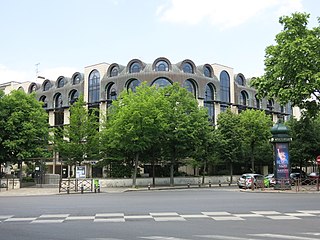
Liceo Español Luis Buñuel is a Spanish international school in Neuilly-sur-Seine, France, in the Paris metropolitan area. Operated by the Spanish Ministry of Education, the school has secundaria obligatoria courses and bachillerato education.
Prostitution in Paris, both in street form and in dedicated facilities has had a long history and remains present to this day.
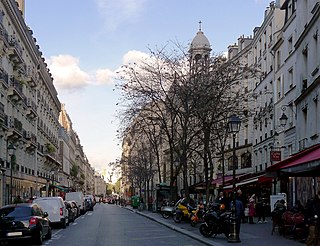
The Rue des Archives is a street in Le Marais at the border of 3rd and 4th arrondissements of Paris, France.




















